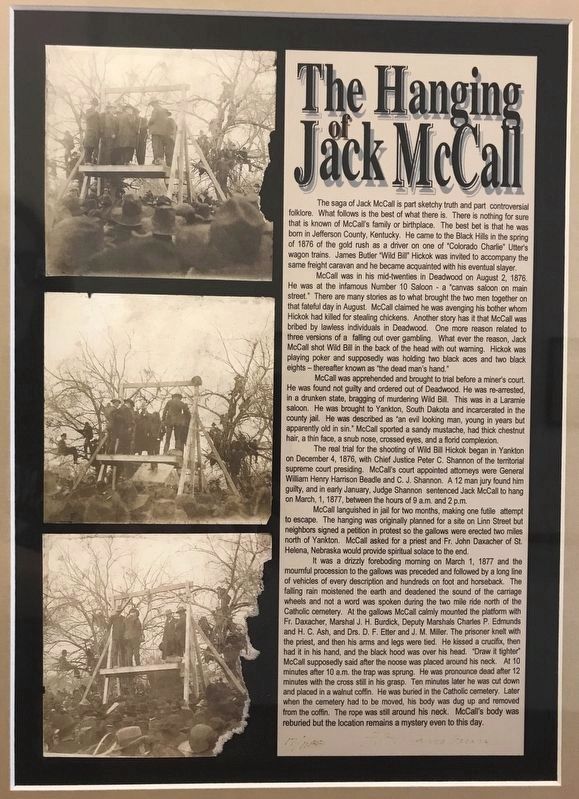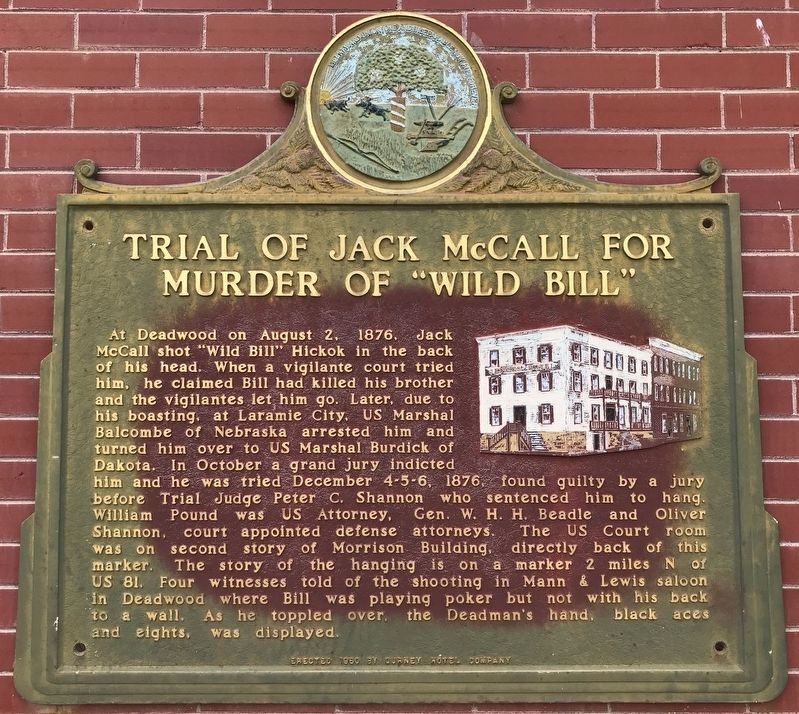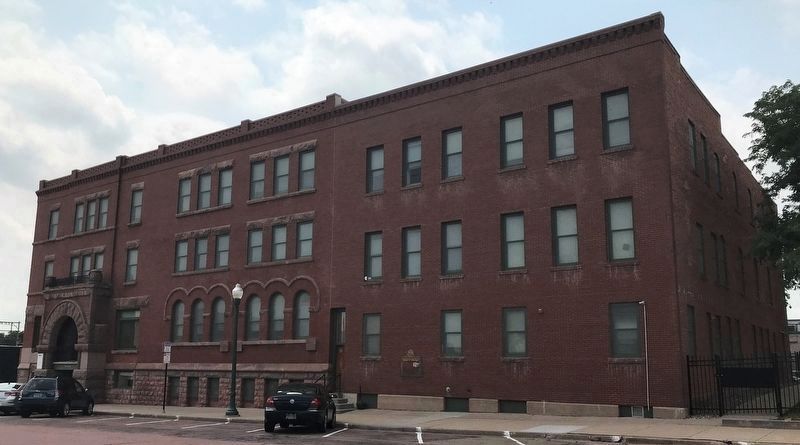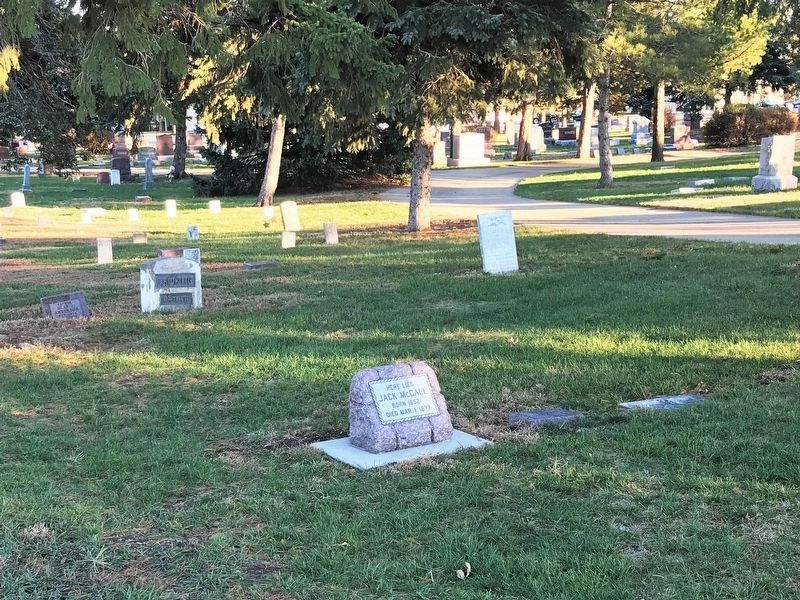Yankton in Yankton County, South Dakota — The American Midwest (Upper Plains)
Trial of Jack McCall for Murder of "Wild Bill"
Erected 1960 by Gurney Hotel Company. (Marker Number 301.)
Topics and series. This historical marker is listed in this topic list: Notable Events. In addition, it is included in the South Dakota State Historical Society Markers series list. A significant historical date for this entry is December 4, 1876.
Location. 42° 52.21′ N, 97° 23.446′ W. Marker is in Yankton, South Dakota, in Yankton County. Marker is on Capital Street, 0.1 miles south of East 4th Street, on the right when traveling south. Touch for map. Marker is at or near this postal address: 301 Capital Street, Yankton SD 57078, United States of America. Touch for directions.
Other nearby markers. At least 8 other markers are within walking distance of this marker. First Territorial Capital (about 400 feet away, measured in a direct line); First Capitol Building of Dakota Territory (about 400 feet away); The Intersection of Third & Walnut (approx. 0.2 miles away); Historic Highway (approx. 0.2 miles away); First Building at Yankton Site (approx. 0.2 miles away); Cramer - Kenyon Home (approx. ¼ mile away); East Wall Yankton Stockade (approx. ¼ mile away); Yankton: Territorial Capital (approx. ¼ mile away). Touch for a list and map of all markers in Yankton.
Related marker. Click here for another marker that is related to this marker.

July 18, 2021
3. The Hanging of Jack McCall Article and Photos
"The Hanging of Jack McCall," located inside the Charles Gurney Hotel building, reads:
The saga of Jack McCall is part sketchy truth and part controversial folklore. What follows is the best of what there is. There is nothing for sure that is known of McCall's family or birthplace. The best bet is that he was born in Jefferson County, Kentucky. He came to the Black Hills in the spring of 1876 of the gold rush as a driver on one of "Colorado Charlie" Utter's wagon trains. James Butler "Wild Bill" Hickok was invited to accompany the same freight caravan and he became acquainted with his eventual slayer.
McCall was in his mid-twenties in Deadwood on August 2, 1876. He was at the infamous Number 10 Saloon - a "canvas saloon on main street." There are many stories as to what brought the two men together on that fateful day in August. McCall claimed he was avenging his bother whom Hickok had killed for stealing chickens. Another story has it that McCall was bribed by lawless individuals in Deadwood. One more reason related to three versions of a falling out over gambling. What ever the reason, Jack McCall shot Wild Bill in the back of the head with out warning. Hickok was playing poker and supposedly was holding two black aces and two black eights - thereafter known as "the dead man's hand."
McCall was apprehended and brought to trial before a miner's court. He was found not guilty and ordered out of Deadwood. He was re-arrested, in a drunken state, bragging of murdering Wild Bill. This was in a Laramie saloon. He was brought to Yankton, South Dakota and incarcerated in the county jail. He was described as "an evil looking man, young in years but apparently old in sin." McCall sported a sandy mustache, had thick chestnut hair, a thin face, a snub nose, crossed eyes, and a florid complexion. The real trial for the shooting of Wild Bill Hickok began in Yankton on December 4, 1876, with Chief Justice Peter C. Shannon of the territorial supreme court presiding. McCall's court appointed attorneys were General William Henry Harrison Beadle and C. J. Shannon. A 12 man jury found him guilty, and in early January, Judge Shannon sentenced Jack McCall to hang on March, 1, 1877, between the hours of 9 a.m. and 2 p.m. McCall languished in jail for two months, making one futile attempt to escape. The hanging was originally planned for a site on Linn Street but neighbors signed a petition in protest so the gallows were erected two miles north of Yankton. McCall asked for a priest and Fr. John Daxacher of St. Helena, Nebraska would provide spiritual solace to the end.
It was a drizzly foreboding morning on March 1, 1877 and the mournful procession to the gallows was preceded and followed by a long line of vehicles of every description and hundreds on foot and horseback. The falling rain moistened the earth and deadened the sound of the carriage wheels and not a word was spoken during the two mile ride north of the Catholic cemetery. At the gallows McCall calmly mounted the platform with Fr. Daxacher, Marshal J. H. Burdick, Deputy Marshals Charles P. Edmunds and H. C. Ash, and Drs. D. F. Etter and J. M. Miller. The prisoner knelt with the priest, and then his arms and legs were tied. He kissed a crucifix, then had it in his hand, and the black hood was over his head. "Draw it tighter" McCall supposedly said after the noose was placed around his neck. At 10 minutes after 10 a.m. the trap was sprung. He was pronounce dead after 12 minutes with the cross still in his grasp. Ten minutes later he was cut down and placed in a walnut coffin. He was buried in the Catholic cemetery. Later when the cemetery had to be moved, his body was dug up and removed from the coffin. The rope was still around his neck. McCall's body was reburied but the location remains a mystery even to this day.
The saga of Jack McCall is part sketchy truth and part controversial folklore. What follows is the best of what there is. There is nothing for sure that is known of McCall's family or birthplace. The best bet is that he was born in Jefferson County, Kentucky. He came to the Black Hills in the spring of 1876 of the gold rush as a driver on one of "Colorado Charlie" Utter's wagon trains. James Butler "Wild Bill" Hickok was invited to accompany the same freight caravan and he became acquainted with his eventual slayer.
McCall was in his mid-twenties in Deadwood on August 2, 1876. He was at the infamous Number 10 Saloon - a "canvas saloon on main street." There are many stories as to what brought the two men together on that fateful day in August. McCall claimed he was avenging his bother whom Hickok had killed for stealing chickens. Another story has it that McCall was bribed by lawless individuals in Deadwood. One more reason related to three versions of a falling out over gambling. What ever the reason, Jack McCall shot Wild Bill in the back of the head with out warning. Hickok was playing poker and supposedly was holding two black aces and two black eights - thereafter known as "the dead man's hand."
McCall was apprehended and brought to trial before a miner's court. He was found not guilty and ordered out of Deadwood. He was re-arrested, in a drunken state, bragging of murdering Wild Bill. This was in a Laramie saloon. He was brought to Yankton, South Dakota and incarcerated in the county jail. He was described as "an evil looking man, young in years but apparently old in sin." McCall sported a sandy mustache, had thick chestnut hair, a thin face, a snub nose, crossed eyes, and a florid complexion. The real trial for the shooting of Wild Bill Hickok began in Yankton on December 4, 1876, with Chief Justice Peter C. Shannon of the territorial supreme court presiding. McCall's court appointed attorneys were General William Henry Harrison Beadle and C. J. Shannon. A 12 man jury found him guilty, and in early January, Judge Shannon sentenced Jack McCall to hang on March, 1, 1877, between the hours of 9 a.m. and 2 p.m. McCall languished in jail for two months, making one futile attempt to escape. The hanging was originally planned for a site on Linn Street but neighbors signed a petition in protest so the gallows were erected two miles north of Yankton. McCall asked for a priest and Fr. John Daxacher of St. Helena, Nebraska would provide spiritual solace to the end.
It was a drizzly foreboding morning on March 1, 1877 and the mournful procession to the gallows was preceded and followed by a long line of vehicles of every description and hundreds on foot and horseback. The falling rain moistened the earth and deadened the sound of the carriage wheels and not a word was spoken during the two mile ride north of the Catholic cemetery. At the gallows McCall calmly mounted the platform with Fr. Daxacher, Marshal J. H. Burdick, Deputy Marshals Charles P. Edmunds and H. C. Ash, and Drs. D. F. Etter and J. M. Miller. The prisoner knelt with the priest, and then his arms and legs were tied. He kissed a crucifix, then had it in his hand, and the black hood was over his head. "Draw it tighter" McCall supposedly said after the noose was placed around his neck. At 10 minutes after 10 a.m. the trap was sprung. He was pronounce dead after 12 minutes with the cross still in his grasp. Ten minutes later he was cut down and placed in a walnut coffin. He was buried in the Catholic cemetery. Later when the cemetery had to be moved, his body was dug up and removed from the coffin. The rope was still around his neck. McCall's body was reburied but the location remains a mystery even to this day.
Credits. This page was last revised on December 7, 2022. It was originally submitted on July 22, 2021. This page has been viewed 1,216 times since then and 155 times this year. Photos: 1, 2, 3. submitted on July 22, 2021. 4. submitted on December 6, 2022. • Bill Pfingsten was the editor who published this page.


